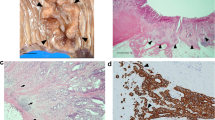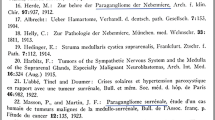Abstract
Background
Cardiac myxoma, the most common primary tumor of the heart, has a variable clinical presentation and immunohistochemical profile. An abundant mucopolysaccharidic matrix exists, including mucin, within cardiac myxoma. This investigation first reports the expressions of mucin genes in cardiac myxoma.
Methods
A retrospective study was conducted between December 1976 and February 2003, comprising 101 consecutive patients with cardiac myxoma who were treated with surgical excision. Detailed clinical parameters also were reviewed. Mucin genes, namely MUC1, MUC2 and MUC5AC, were studied immunohistochemically in 47 randomly selected patients.
Results
The study group contained 57 (57%) women and 44 (43%) men, with a mean age of 38±21 years. Their presentations included: asymptomatic (41%), dyspnea (35%), stroke (23%), chest pain (7%), fever (6%), syncope (5%) and tricuspid regurgitation (70%). The sample included 90 myxoma located in the left atrium, 3 (3%) recurrent myxoma and 8 (8%) myxoma not located in the left atrium. The myxoma did not differ with location or clinical event in terms of pathological scores, such as vascular proliferation, inflammation, cellularity, hyaline, calcification and thrombosis. Cardiac myxoma is characterized by excessive mucus secretion. Expression of membrane-associated MUC1 was considerably higher than that of the secreted mucins, MUC2 and MUC5AC (P<0.05). Furthermore, expression of MUC5AC is related to lesser embolism (P<0.05).
Conclusions
This work first examined the immunohistochemical expression of mucin (MUC1, MUC2 and MUC5AC) in cardiac myxoma. This investigation then showed that the expression of representative membrane-associated mucin, MUC1, and/or secretory mucins, MUC2 and MUC5AC, in cardiac myxoma was associated with important tumor clinicopathological characteristics. Moreover, MUC5AC appears related to lesser embolism. This approach can help distinguish the potential roles of secretory mucins versus membrane-associated mucins in the development of cardiac myxoma.

Similar content being viewed by others
References
Acebo E, Val-Bernal JF, Gomez-Roman JJ, Revuelta JM (2003) Clinicopathologic study and DNA analysis of 37 cardiac myxomas: a 28-year experience. Chest 123:1379–1385
Basso C, Valente M, Casarotto D, Thiene G (1997) Cardiac lithomyxoma. Am J Cardiol 80:1249–1251
Chu PH, Jung SM, Yeh TS, Yeh CH, Wang CL (2004) Mucin genes expression in cardiac myxoma. Int J Clin Prac 58:306–309
Copin MC, Buisine MP, Devisme L, Leroy X, Escande F, Gosselin B, Aubert JP, Porchet N (2001) Normal respiratory mucosa, precursor lesions and lung carcinomas: differential expression of human mucin genes. Front Biosci 6:D1264–D1275
Corfield AP, Carroll D, Myerscough N, Probert CS (2001) Mucins in the gastrointestinal tract in health and disease. Front Biosci 6:D1321–D1357
Gum JR Jr (1995) Human mucin glycoproteins: varied structures predict diverse properties and specific functions. Biochem Soc Trans 23:795–799
Moniaux N, Escande F, Porchet N, Aubert JP and Batra SK (2001) Structural organization and classification of the human mucin genes. Front Biosci 6:D1192–D1206
Pinede L, Duhaut P, Loire R (2001) Clinical presentation of left atrial cardiac myxoma. A series of 112 consecutive cases. Medicine (Baltimore) 80:159–172
Porchet N, Buisine MP, Desseyn JL, Moniaux N, Nollet S, Degand P, Pigny P, Van Seuningen I, Laine A, Aubert JP (1999) MUC genes: a superfamily of genes? Towards a functional classification of human apomucins. J Soc Biol 193:85–99
Pucci A, Gagliardotto P, Zanini C, Pansini S, di Summa M, Mollo F (2000) Histopathologic and clinical characterization of cardiac myxoma: review of 53 cases from a single institution. Am Heart J 140:134–138
Rahn JJ, Dabbagh L, Pasdar M, Hugh JC (2001) The importance of MUC1 cellular localization in patients with breast carcinoma: an immunohistologic study of 71 patients and review of the literature. Cancer 91:1973–1982
Reynen K (1995) Cardiac myxomas. N Engl J Med 333:1610–1617
Rose MC, Nickola TJ, Voynow JA (2001) Airway mucus obstruction: mucin glycoproteins, MUC gene regulation and goblet cell hyperplasia. Am J Respir Cell Mol Biol 25:533–537
Yonezawa S, Sato E (1999) Expression of mucin antigens in human cancers and its relationship with malignancy potential. Pathol Int 47:813–830
Acknowledgements
Dr. Chu is supported by grants NHRI-EX91–9108SC, NHRI-EX92–9108SC and NHRI-EX93–9108SC from the National Health Research Institute of Taiwan. Dr. Jung is supported by CMRPG33044 from Chang Gung Memorial Hospital at Taiwan.
Author information
Authors and Affiliations
Corresponding author
Rights and permissions
About this article
Cite this article
Chu, PH., Jung, SM., Yeh, TS. et al. MUC1, MUC2 and MUC5AC expressions in cardiac myxoma. Virchows Arch 446, 52–55 (2005). https://doi.org/10.1007/s00428-004-1147-5
Received:
Accepted:
Published:
Issue Date:
DOI: https://doi.org/10.1007/s00428-004-1147-5




